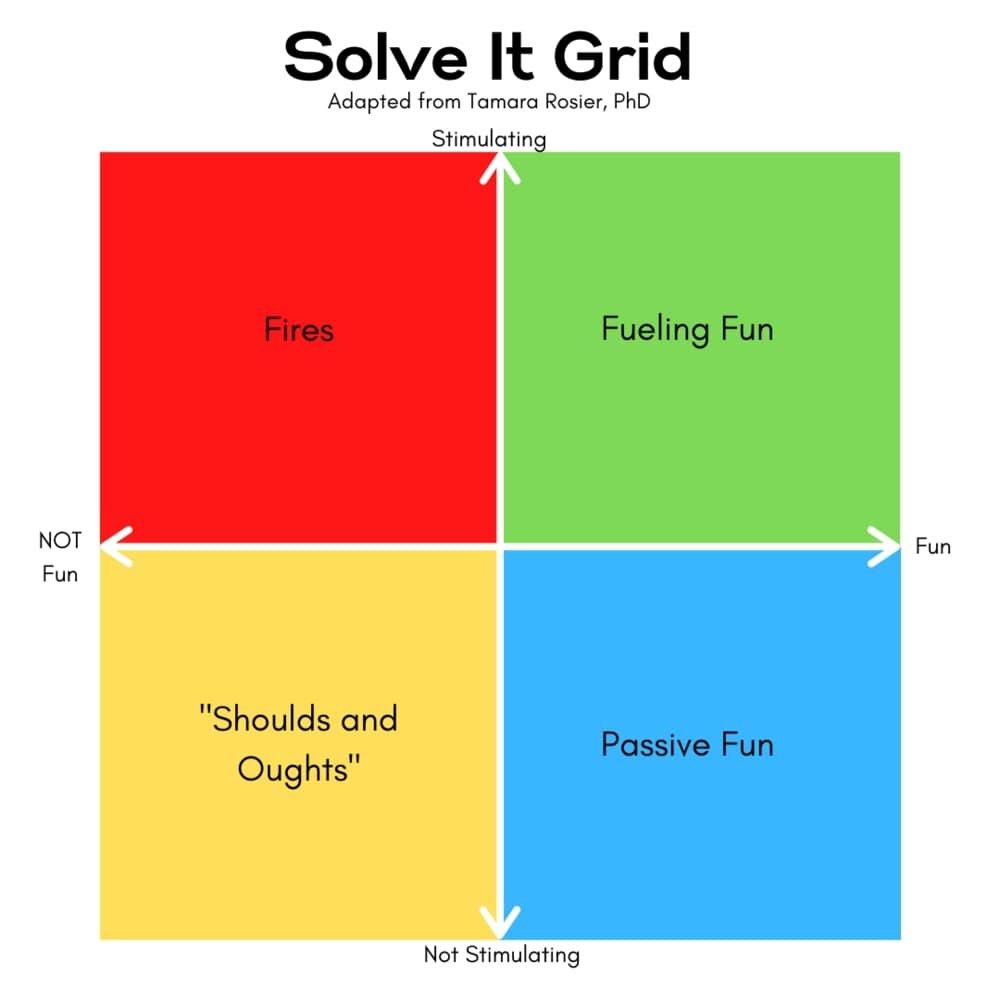The solve it grid helps us find patterns through these two dimensions in our tasks.
We tend to alternate to the opposite one
- fires force us have passive fun so we can find some fun in our day
- the satisfaction from fueling fun affords us to do should and oughts since
## Grid

## Dimensions
By implementing both, you get into [[Flow State]]
People with ADHD can measure their tasks on two spectrums:
### Fun
(intrinsic motivation and emotional enjoyment)
- **Novelty and Variety**: Activities that provide a sense of novelty, excitement, or unpredictability to help capture and maintain attention.
- _Does this task offer something new or different that captures my interest?_
- **Immediate Gratification**: Offer immediate rewards or feedback. This would be activities with clear and immediate outcomes or feedback loops.
- _Can I see immediate results or progress when working on this task?_
- **Sensory Appeal**: Tasks that engage multiple senses or provide sensory stimulation may be more enjoyable. This could include activities with vibrant visuals, tactile elements, or interactive components.
- _Does this task engage my senses or provide sensory stimulation that I find enjoyable?_
#### Question Reference
- _Does this task offer something new or different that captures my interest?_
- \*Can I see immediate results or progress when working on this task?
- _Does this task engage my senses or provide sensory stimulation that I find enjoyable?_
### Stimulation
- **Complexity and Challenge**: The right amount of complexity or challenge can promote engagement, which can come in the form of problem-solving, creativity, or critical thinking.
- _Does this task require problem-solving or critical thinking skills that challenge me?_
- **Hyperfocus Potential**: Absorption and intense focus on a particular activity through clear goals and feedback. This is because in the [[Flow State]], stimluation is the result of both dimensions (user capability, task difficulty)
- _Is there a possibility that I might become deeply absorbed in this task and lose track of time?_
- **Task Autonomy**: Activities that allow for flexibility in how you work on it.
- _Can I approach this task in different ways or adapt it to suit my preferences and needs?_
#### Question Reference
- \*Does this task require problem-solving or critical thinking skills that challenge me?
- _Is there a possibility that I might become deeply absorbed in this task and lose track of time?_
- _Can I approach this task in different ways or adapt it to suit my preferences and needs?_
## Squares
### Fires
Fuelled by stimulation (deadline upcoming).
We do them because we have to, not because we particularly enjoy it. This happens often if we wait for the time where we feel stimulated enough to do it.
Fire since it's intense but not enjoyable, causing stress and requiring some relaxation at the end of the day.
The problem is that red causes burnout if done for an extended time, and will cause us to recharge with the opposite via passive fun.
### Passive Fun
Activities that are fun but may not entirely be intellectually challenging or stimulating.
### Shoulds and Oughts
Not to be mistaken with the [[Someday Maybe List]] despite similar naming.
Rather, it's mundane things that we don't like to do like chores or in my case doing manual tests 💀
### Fueling Fun
The intrinsically fulfilling activities you enjoy doing right off the bat.
The activities that recharge you and promote [[Flow State]].
## Usage
The common theme is that you put out fires (non-fun studying or work), but then after you need to recharge and get your fun fixation.
This leads you to naturally engage in blue activities like doomscrolling, playing games, or watching TV.
It isn't inherently bad, but problems can occur when we get sucked into these activities for longer than we should—after hyper-fixating on something for 3 hours, you end up checking YouTube and end up to take a quick break but going down a rabbit hole.
If we are deprived of fun while putting out stressing red fires, then why would we want to go back? When will we have the energy to work on the shoulds and oughts, or make time for our fuelling fun activities?
Instead, we should try for cycling between green and yellow tasks.
Reds should be prevented by keeping them green, and blues should be prevented by
This promotes [[Work cycles]] which have benefits and are more natural to how we should work.
### Example
From https://www.additudemag.com/time-on-your-side/
> Martyn used the grid in four phases: 1. Learning how to use the Solve-it Grid; 2. Analyzing how he currently uses his time and energy; 3. Detecting his work patterns; 4. Creating a plan to address the patterns. After learning about the grid, he noticed that doing well in his job meant performing many small tedious tasks in the Yellow quadrant. Instead of engaging the Yellow quadrant, he defaulted to Blue quadrant activities and felt guilty about it. After avoiding Yellow for a while, he fired himself up to turn those tiresome tasks into Red quadrant activities. Exhausted, he would return to Blue activities.
> Martyn decided that his use of the Blue quadrant created many of his work challenges. His plan included dividing his day into small and manageable Yellow work zones, made tolerable by a few fun activities in the Blue quadrant. He learned to treat himself to Green by scheduling time to think about ways to develop a side business. The grid helped him balance his time and his life.